VU Sydney BLO1105 Business Law: Contract and ACL Analysis S1 2018
VerifiedAdded on 2023/06/12
|11
|2421
|248
Case Study
AI Summary
This case study analyzes contract law principles and breaches of the Australian Consumer Law (ACL) in a business context. It examines the formation of a contract between Magda and Avinash, focusing on offer, acceptance, and counter-offers, ultimately concluding that no valid contract was formed due to a lack of unequivocal acceptance. The study further investigates potential breaches of the ACL by Magda in her dealings with Elton, specifically concerning misleading and deceptive conduct under Section 18 and violations of Section 56 related to the accurate description of goods. The analysis concludes that Magda breached both sections, entitling Elton to remedies under the consumer guarantees. Additionally, the study discusses the validity of consideration in contracts, referencing relevant case law to illustrate situations where consideration may be deemed invalid, such as past consideration or existing contractual duties.
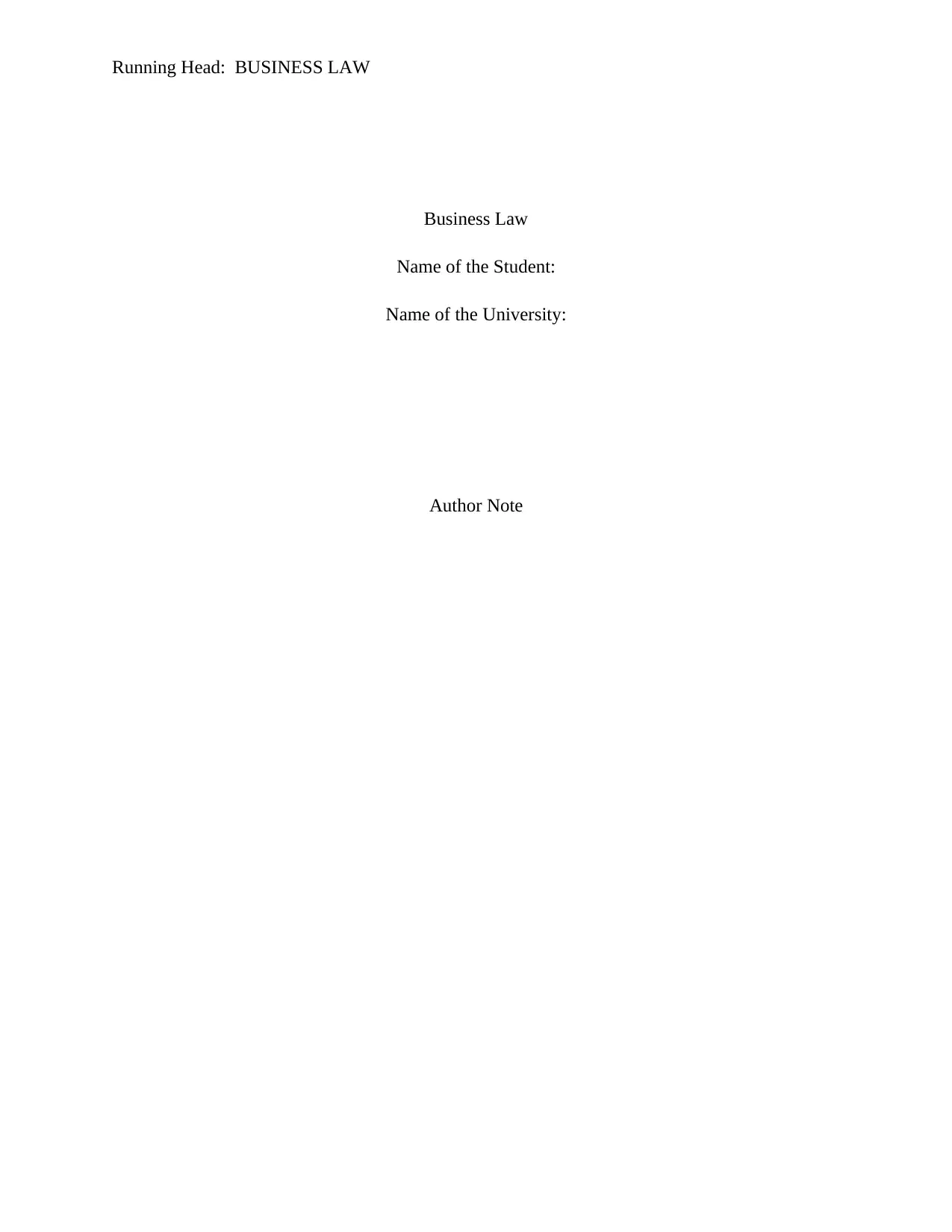
Running Head: BUSINESS LAW
Business Law
Name of the Student:
Name of the University:
Author Note
Business Law
Name of the Student:
Name of the University:
Author Note
Paraphrase This Document
Need a fresh take? Get an instant paraphrase of this document with our AI Paraphraser
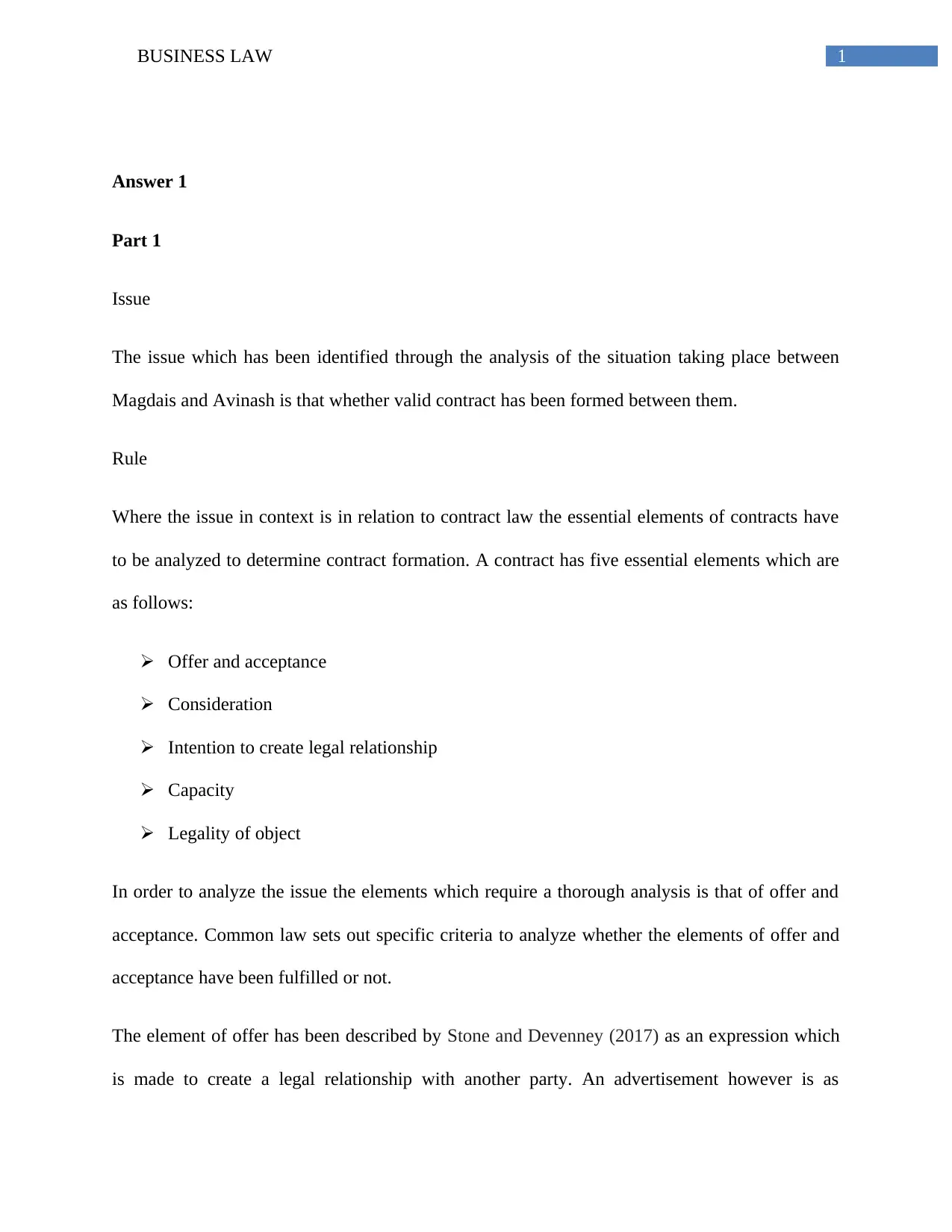
1BUSINESS LAW
Answer 1
Part 1
Issue
The issue which has been identified through the analysis of the situation taking place between
Magdais and Avinash is that whether valid contract has been formed between them.
Rule
Where the issue in context is in relation to contract law the essential elements of contracts have
to be analyzed to determine contract formation. A contract has five essential elements which are
as follows:
Offer and acceptance
Consideration
Intention to create legal relationship
Capacity
Legality of object
In order to analyze the issue the elements which require a thorough analysis is that of offer and
acceptance. Common law sets out specific criteria to analyze whether the elements of offer and
acceptance have been fulfilled or not.
The element of offer has been described by Stone and Devenney (2017) as an expression which
is made to create a legal relationship with another party. An advertisement however is as
Answer 1
Part 1
Issue
The issue which has been identified through the analysis of the situation taking place between
Magdais and Avinash is that whether valid contract has been formed between them.
Rule
Where the issue in context is in relation to contract law the essential elements of contracts have
to be analyzed to determine contract formation. A contract has five essential elements which are
as follows:
Offer and acceptance
Consideration
Intention to create legal relationship
Capacity
Legality of object
In order to analyze the issue the elements which require a thorough analysis is that of offer and
acceptance. Common law sets out specific criteria to analyze whether the elements of offer and
acceptance have been fulfilled or not.
The element of offer has been described by Stone and Devenney (2017) as an expression which
is made to create a legal relationship with another party. An advertisement however is as
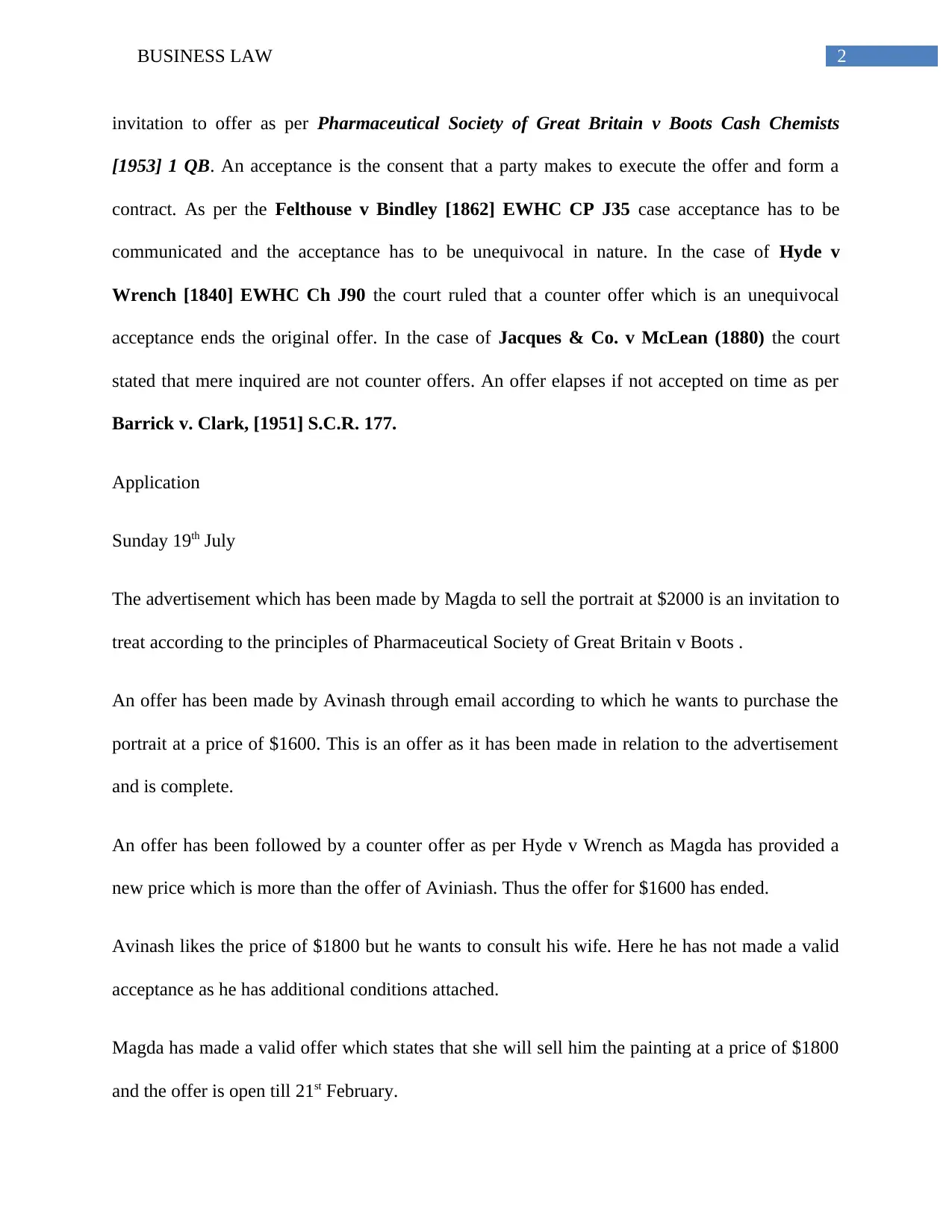
2BUSINESS LAW
invitation to offer as per Pharmaceutical Society of Great Britain v Boots Cash Chemists
[1953] 1 QB. An acceptance is the consent that a party makes to execute the offer and form a
contract. As per the Felthouse v Bindley [1862] EWHC CP J35 case acceptance has to be
communicated and the acceptance has to be unequivocal in nature. In the case of Hyde v
Wrench [1840] EWHC Ch J90 the court ruled that a counter offer which is an unequivocal
acceptance ends the original offer. In the case of Jacques & Co. v McLean (1880) the court
stated that mere inquired are not counter offers. An offer elapses if not accepted on time as per
Barrick v. Clark, [1951] S.C.R. 177.
Application
Sunday 19th July
The advertisement which has been made by Magda to sell the portrait at $2000 is an invitation to
treat according to the principles of Pharmaceutical Society of Great Britain v Boots .
An offer has been made by Avinash through email according to which he wants to purchase the
portrait at a price of $1600. This is an offer as it has been made in relation to the advertisement
and is complete.
An offer has been followed by a counter offer as per Hyde v Wrench as Magda has provided a
new price which is more than the offer of Aviniash. Thus the offer for $1600 has ended.
Avinash likes the price of $1800 but he wants to consult his wife. Here he has not made a valid
acceptance as he has additional conditions attached.
Magda has made a valid offer which states that she will sell him the painting at a price of $1800
and the offer is open till 21st February.
invitation to offer as per Pharmaceutical Society of Great Britain v Boots Cash Chemists
[1953] 1 QB. An acceptance is the consent that a party makes to execute the offer and form a
contract. As per the Felthouse v Bindley [1862] EWHC CP J35 case acceptance has to be
communicated and the acceptance has to be unequivocal in nature. In the case of Hyde v
Wrench [1840] EWHC Ch J90 the court ruled that a counter offer which is an unequivocal
acceptance ends the original offer. In the case of Jacques & Co. v McLean (1880) the court
stated that mere inquired are not counter offers. An offer elapses if not accepted on time as per
Barrick v. Clark, [1951] S.C.R. 177.
Application
Sunday 19th July
The advertisement which has been made by Magda to sell the portrait at $2000 is an invitation to
treat according to the principles of Pharmaceutical Society of Great Britain v Boots .
An offer has been made by Avinash through email according to which he wants to purchase the
portrait at a price of $1600. This is an offer as it has been made in relation to the advertisement
and is complete.
An offer has been followed by a counter offer as per Hyde v Wrench as Magda has provided a
new price which is more than the offer of Aviniash. Thus the offer for $1600 has ended.
Avinash likes the price of $1800 but he wants to consult his wife. Here he has not made a valid
acceptance as he has additional conditions attached.
Magda has made a valid offer which states that she will sell him the painting at a price of $1800
and the offer is open till 21st February.
⊘ This is a preview!⊘
Do you want full access?
Subscribe today to unlock all pages.

Trusted by 1+ million students worldwide
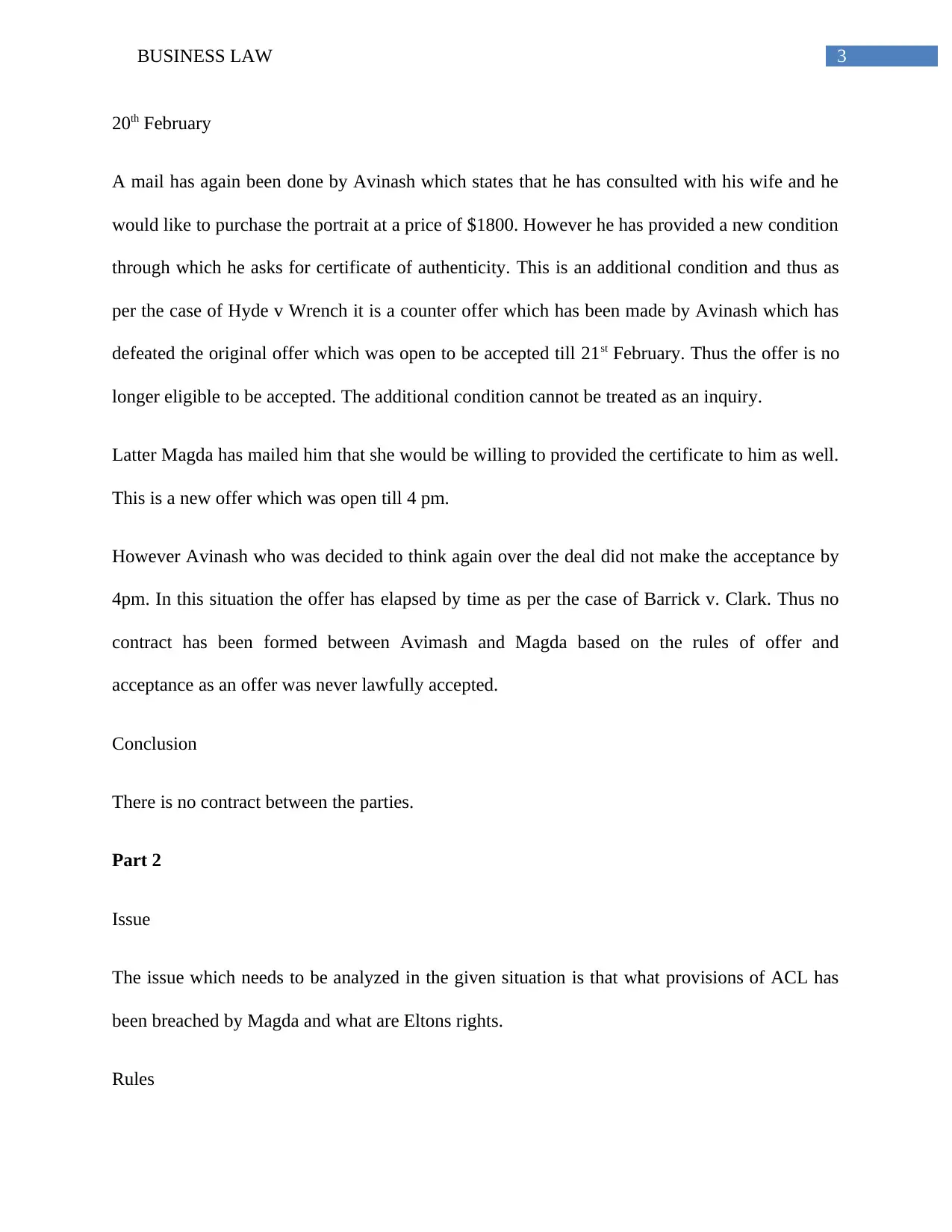
3BUSINESS LAW
20th February
A mail has again been done by Avinash which states that he has consulted with his wife and he
would like to purchase the portrait at a price of $1800. However he has provided a new condition
through which he asks for certificate of authenticity. This is an additional condition and thus as
per the case of Hyde v Wrench it is a counter offer which has been made by Avinash which has
defeated the original offer which was open to be accepted till 21st February. Thus the offer is no
longer eligible to be accepted. The additional condition cannot be treated as an inquiry.
Latter Magda has mailed him that she would be willing to provided the certificate to him as well.
This is a new offer which was open till 4 pm.
However Avinash who was decided to think again over the deal did not make the acceptance by
4pm. In this situation the offer has elapsed by time as per the case of Barrick v. Clark. Thus no
contract has been formed between Avimash and Magda based on the rules of offer and
acceptance as an offer was never lawfully accepted.
Conclusion
There is no contract between the parties.
Part 2
Issue
The issue which needs to be analyzed in the given situation is that what provisions of ACL has
been breached by Magda and what are Eltons rights.
Rules
20th February
A mail has again been done by Avinash which states that he has consulted with his wife and he
would like to purchase the portrait at a price of $1800. However he has provided a new condition
through which he asks for certificate of authenticity. This is an additional condition and thus as
per the case of Hyde v Wrench it is a counter offer which has been made by Avinash which has
defeated the original offer which was open to be accepted till 21st February. Thus the offer is no
longer eligible to be accepted. The additional condition cannot be treated as an inquiry.
Latter Magda has mailed him that she would be willing to provided the certificate to him as well.
This is a new offer which was open till 4 pm.
However Avinash who was decided to think again over the deal did not make the acceptance by
4pm. In this situation the offer has elapsed by time as per the case of Barrick v. Clark. Thus no
contract has been formed between Avimash and Magda based on the rules of offer and
acceptance as an offer was never lawfully accepted.
Conclusion
There is no contract between the parties.
Part 2
Issue
The issue which needs to be analyzed in the given situation is that what provisions of ACL has
been breached by Magda and what are Eltons rights.
Rules
Paraphrase This Document
Need a fresh take? Get an instant paraphrase of this document with our AI Paraphraser
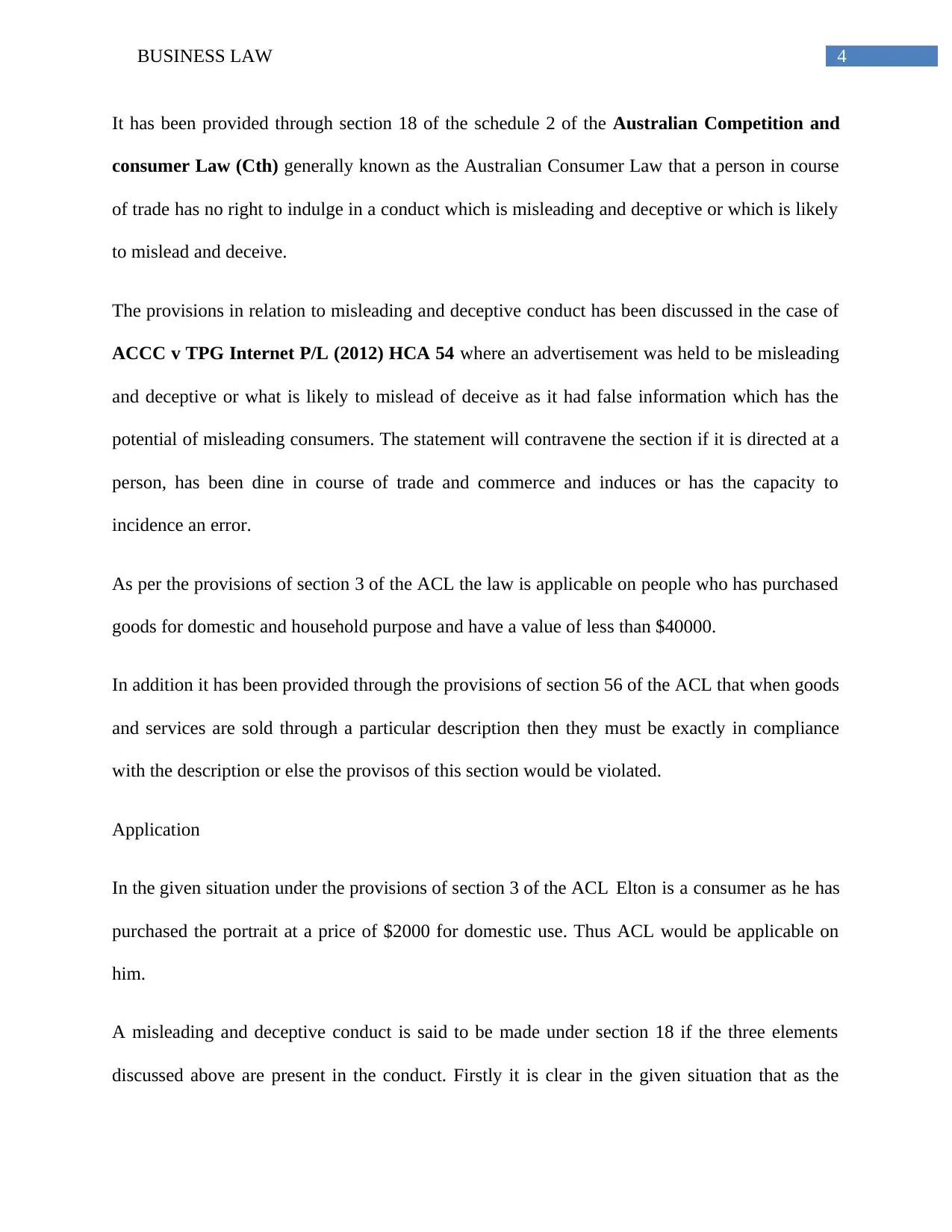
4BUSINESS LAW
It has been provided through section 18 of the schedule 2 of the Australian Competition and
consumer Law (Cth) generally known as the Australian Consumer Law that a person in course
of trade has no right to indulge in a conduct which is misleading and deceptive or which is likely
to mislead and deceive.
The provisions in relation to misleading and deceptive conduct has been discussed in the case of
ACCC v TPG Internet P/L (2012) HCA 54 where an advertisement was held to be misleading
and deceptive or what is likely to mislead of deceive as it had false information which has the
potential of misleading consumers. The statement will contravene the section if it is directed at a
person, has been dine in course of trade and commerce and induces or has the capacity to
incidence an error.
As per the provisions of section 3 of the ACL the law is applicable on people who has purchased
goods for domestic and household purpose and have a value of less than $40000.
In addition it has been provided through the provisions of section 56 of the ACL that when goods
and services are sold through a particular description then they must be exactly in compliance
with the description or else the provisos of this section would be violated.
Application
In the given situation under the provisions of section 3 of the ACL Elton is a consumer as he has
purchased the portrait at a price of $2000 for domestic use. Thus ACL would be applicable on
him.
A misleading and deceptive conduct is said to be made under section 18 if the three elements
discussed above are present in the conduct. Firstly it is clear in the given situation that as the
It has been provided through section 18 of the schedule 2 of the Australian Competition and
consumer Law (Cth) generally known as the Australian Consumer Law that a person in course
of trade has no right to indulge in a conduct which is misleading and deceptive or which is likely
to mislead and deceive.
The provisions in relation to misleading and deceptive conduct has been discussed in the case of
ACCC v TPG Internet P/L (2012) HCA 54 where an advertisement was held to be misleading
and deceptive or what is likely to mislead of deceive as it had false information which has the
potential of misleading consumers. The statement will contravene the section if it is directed at a
person, has been dine in course of trade and commerce and induces or has the capacity to
incidence an error.
As per the provisions of section 3 of the ACL the law is applicable on people who has purchased
goods for domestic and household purpose and have a value of less than $40000.
In addition it has been provided through the provisions of section 56 of the ACL that when goods
and services are sold through a particular description then they must be exactly in compliance
with the description or else the provisos of this section would be violated.
Application
In the given situation under the provisions of section 3 of the ACL Elton is a consumer as he has
purchased the portrait at a price of $2000 for domestic use. Thus ACL would be applicable on
him.
A misleading and deceptive conduct is said to be made under section 18 if the three elements
discussed above are present in the conduct. Firstly it is clear in the given situation that as the
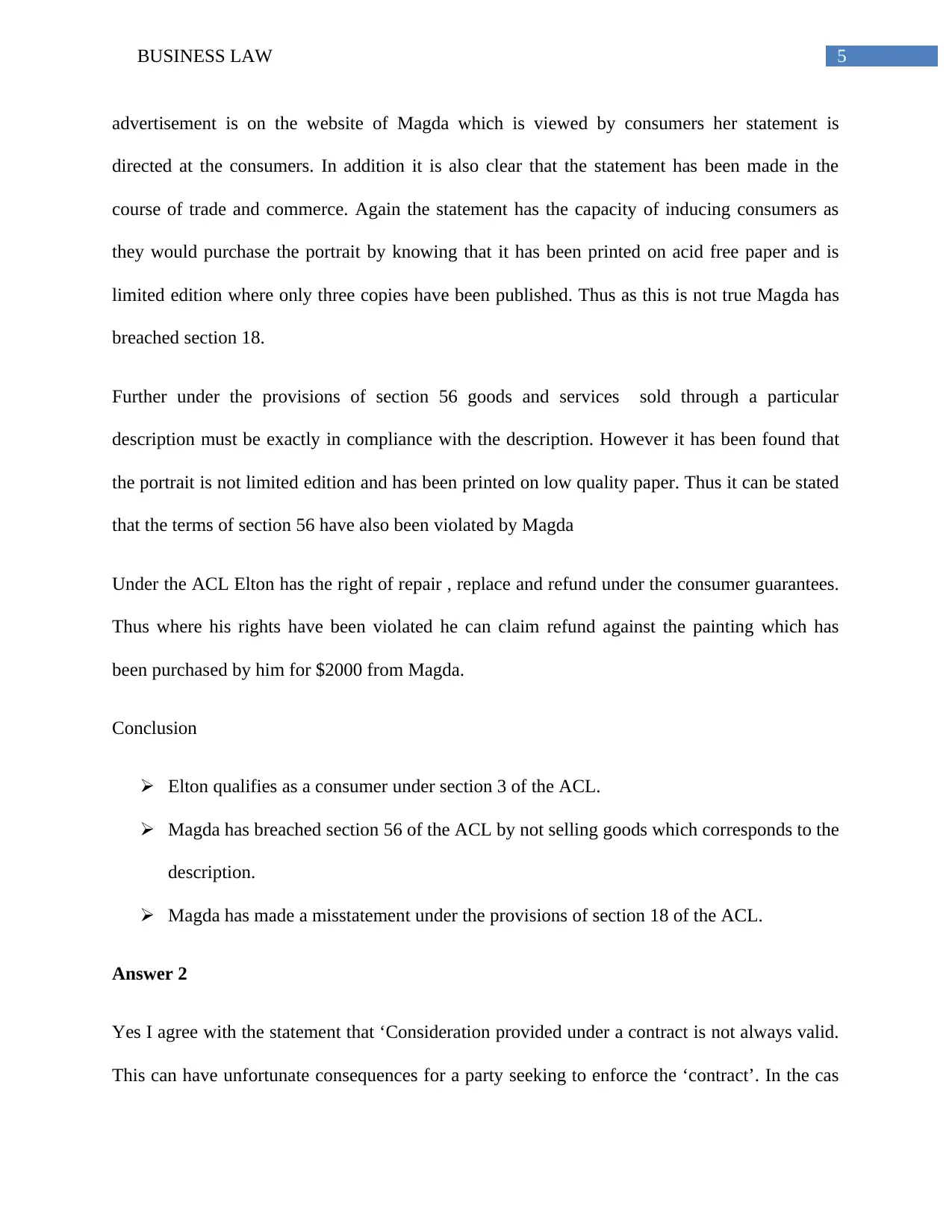
5BUSINESS LAW
advertisement is on the website of Magda which is viewed by consumers her statement is
directed at the consumers. In addition it is also clear that the statement has been made in the
course of trade and commerce. Again the statement has the capacity of inducing consumers as
they would purchase the portrait by knowing that it has been printed on acid free paper and is
limited edition where only three copies have been published. Thus as this is not true Magda has
breached section 18.
Further under the provisions of section 56 goods and services sold through a particular
description must be exactly in compliance with the description. However it has been found that
the portrait is not limited edition and has been printed on low quality paper. Thus it can be stated
that the terms of section 56 have also been violated by Magda
Under the ACL Elton has the right of repair , replace and refund under the consumer guarantees.
Thus where his rights have been violated he can claim refund against the painting which has
been purchased by him for $2000 from Magda.
Conclusion
Elton qualifies as a consumer under section 3 of the ACL.
Magda has breached section 56 of the ACL by not selling goods which corresponds to the
description.
Magda has made a misstatement under the provisions of section 18 of the ACL.
Answer 2
Yes I agree with the statement that ‘Consideration provided under a contract is not always valid.
This can have unfortunate consequences for a party seeking to enforce the ‘contract’. In the cas
advertisement is on the website of Magda which is viewed by consumers her statement is
directed at the consumers. In addition it is also clear that the statement has been made in the
course of trade and commerce. Again the statement has the capacity of inducing consumers as
they would purchase the portrait by knowing that it has been printed on acid free paper and is
limited edition where only three copies have been published. Thus as this is not true Magda has
breached section 18.
Further under the provisions of section 56 goods and services sold through a particular
description must be exactly in compliance with the description. However it has been found that
the portrait is not limited edition and has been printed on low quality paper. Thus it can be stated
that the terms of section 56 have also been violated by Magda
Under the ACL Elton has the right of repair , replace and refund under the consumer guarantees.
Thus where his rights have been violated he can claim refund against the painting which has
been purchased by him for $2000 from Magda.
Conclusion
Elton qualifies as a consumer under section 3 of the ACL.
Magda has breached section 56 of the ACL by not selling goods which corresponds to the
description.
Magda has made a misstatement under the provisions of section 18 of the ACL.
Answer 2
Yes I agree with the statement that ‘Consideration provided under a contract is not always valid.
This can have unfortunate consequences for a party seeking to enforce the ‘contract’. In the cas
⊘ This is a preview!⊘
Do you want full access?
Subscribe today to unlock all pages.

Trusted by 1+ million students worldwide
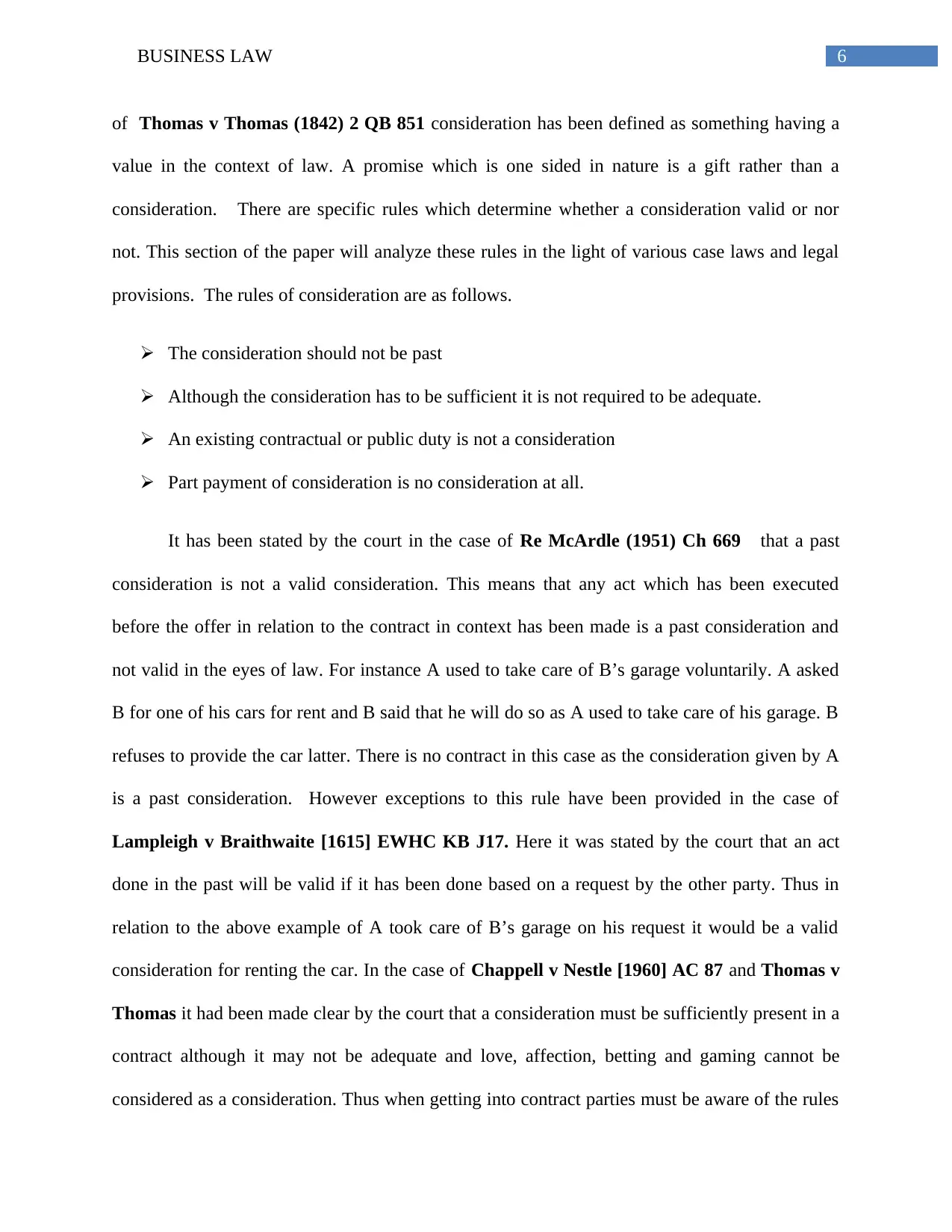
6BUSINESS LAW
of Thomas v Thomas (1842) 2 QB 851 consideration has been defined as something having a
value in the context of law. A promise which is one sided in nature is a gift rather than a
consideration. There are specific rules which determine whether a consideration valid or nor
not. This section of the paper will analyze these rules in the light of various case laws and legal
provisions. The rules of consideration are as follows.
The consideration should not be past
Although the consideration has to be sufficient it is not required to be adequate.
An existing contractual or public duty is not a consideration
Part payment of consideration is no consideration at all.
It has been stated by the court in the case of Re McArdle (1951) Ch 669 that a past
consideration is not a valid consideration. This means that any act which has been executed
before the offer in relation to the contract in context has been made is a past consideration and
not valid in the eyes of law. For instance A used to take care of B’s garage voluntarily. A asked
B for one of his cars for rent and B said that he will do so as A used to take care of his garage. B
refuses to provide the car latter. There is no contract in this case as the consideration given by A
is a past consideration. However exceptions to this rule have been provided in the case of
Lampleigh v Braithwaite [1615] EWHC KB J17. Here it was stated by the court that an act
done in the past will be valid if it has been done based on a request by the other party. Thus in
relation to the above example of A took care of B’s garage on his request it would be a valid
consideration for renting the car. In the case of Chappell v Nestle [1960] AC 87 and Thomas v
Thomas it had been made clear by the court that a consideration must be sufficiently present in a
contract although it may not be adequate and love, affection, betting and gaming cannot be
considered as a consideration. Thus when getting into contract parties must be aware of the rules
of Thomas v Thomas (1842) 2 QB 851 consideration has been defined as something having a
value in the context of law. A promise which is one sided in nature is a gift rather than a
consideration. There are specific rules which determine whether a consideration valid or nor
not. This section of the paper will analyze these rules in the light of various case laws and legal
provisions. The rules of consideration are as follows.
The consideration should not be past
Although the consideration has to be sufficient it is not required to be adequate.
An existing contractual or public duty is not a consideration
Part payment of consideration is no consideration at all.
It has been stated by the court in the case of Re McArdle (1951) Ch 669 that a past
consideration is not a valid consideration. This means that any act which has been executed
before the offer in relation to the contract in context has been made is a past consideration and
not valid in the eyes of law. For instance A used to take care of B’s garage voluntarily. A asked
B for one of his cars for rent and B said that he will do so as A used to take care of his garage. B
refuses to provide the car latter. There is no contract in this case as the consideration given by A
is a past consideration. However exceptions to this rule have been provided in the case of
Lampleigh v Braithwaite [1615] EWHC KB J17. Here it was stated by the court that an act
done in the past will be valid if it has been done based on a request by the other party. Thus in
relation to the above example of A took care of B’s garage on his request it would be a valid
consideration for renting the car. In the case of Chappell v Nestle [1960] AC 87 and Thomas v
Thomas it had been made clear by the court that a consideration must be sufficiently present in a
contract although it may not be adequate and love, affection, betting and gaming cannot be
considered as a consideration. Thus when getting into contract parties must be aware of the rules
Paraphrase This Document
Need a fresh take? Get an instant paraphrase of this document with our AI Paraphraser
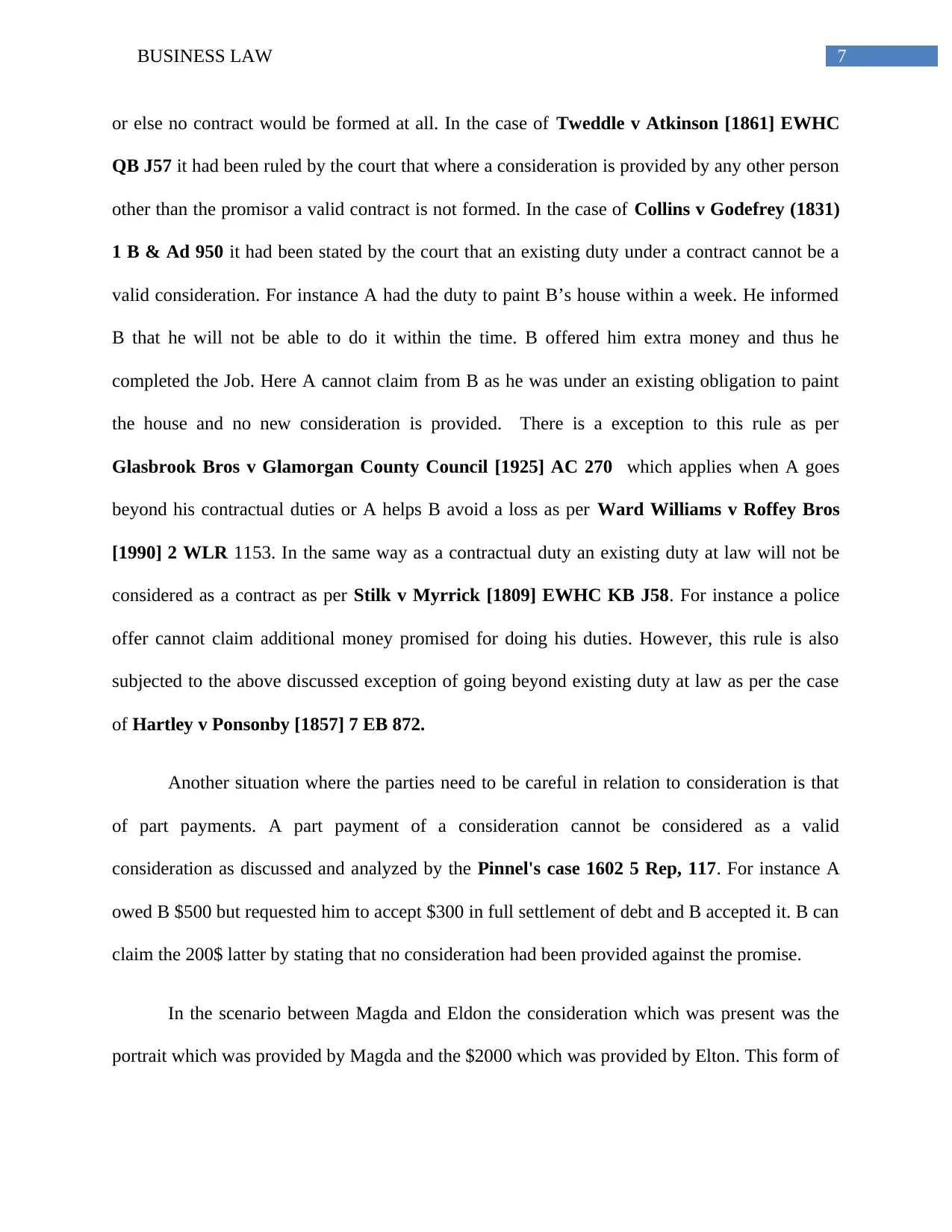
7BUSINESS LAW
or else no contract would be formed at all. In the case of Tweddle v Atkinson [1861] EWHC
QB J57 it had been ruled by the court that where a consideration is provided by any other person
other than the promisor a valid contract is not formed. In the case of Collins v Godefrey (1831)
1 B & Ad 950 it had been stated by the court that an existing duty under a contract cannot be a
valid consideration. For instance A had the duty to paint B’s house within a week. He informed
B that he will not be able to do it within the time. B offered him extra money and thus he
completed the Job. Here A cannot claim from B as he was under an existing obligation to paint
the house and no new consideration is provided. There is a exception to this rule as per
Glasbrook Bros v Glamorgan County Council [1925] AC 270 which applies when A goes
beyond his contractual duties or A helps B avoid a loss as per Ward Williams v Roffey Bros
[1990] 2 WLR 1153. In the same way as a contractual duty an existing duty at law will not be
considered as a contract as per Stilk v Myrrick [1809] EWHC KB J58. For instance a police
offer cannot claim additional money promised for doing his duties. However, this rule is also
subjected to the above discussed exception of going beyond existing duty at law as per the case
of Hartley v Ponsonby [1857] 7 EB 872.
Another situation where the parties need to be careful in relation to consideration is that
of part payments. A part payment of a consideration cannot be considered as a valid
consideration as discussed and analyzed by the Pinnel's case 1602 5 Rep, 117. For instance A
owed B $500 but requested him to accept $300 in full settlement of debt and B accepted it. B can
claim the 200$ latter by stating that no consideration had been provided against the promise.
In the scenario between Magda and Eldon the consideration which was present was the
portrait which was provided by Magda and the $2000 which was provided by Elton. This form of
or else no contract would be formed at all. In the case of Tweddle v Atkinson [1861] EWHC
QB J57 it had been ruled by the court that where a consideration is provided by any other person
other than the promisor a valid contract is not formed. In the case of Collins v Godefrey (1831)
1 B & Ad 950 it had been stated by the court that an existing duty under a contract cannot be a
valid consideration. For instance A had the duty to paint B’s house within a week. He informed
B that he will not be able to do it within the time. B offered him extra money and thus he
completed the Job. Here A cannot claim from B as he was under an existing obligation to paint
the house and no new consideration is provided. There is a exception to this rule as per
Glasbrook Bros v Glamorgan County Council [1925] AC 270 which applies when A goes
beyond his contractual duties or A helps B avoid a loss as per Ward Williams v Roffey Bros
[1990] 2 WLR 1153. In the same way as a contractual duty an existing duty at law will not be
considered as a contract as per Stilk v Myrrick [1809] EWHC KB J58. For instance a police
offer cannot claim additional money promised for doing his duties. However, this rule is also
subjected to the above discussed exception of going beyond existing duty at law as per the case
of Hartley v Ponsonby [1857] 7 EB 872.
Another situation where the parties need to be careful in relation to consideration is that
of part payments. A part payment of a consideration cannot be considered as a valid
consideration as discussed and analyzed by the Pinnel's case 1602 5 Rep, 117. For instance A
owed B $500 but requested him to accept $300 in full settlement of debt and B accepted it. B can
claim the 200$ latter by stating that no consideration had been provided against the promise.
In the scenario between Magda and Eldon the consideration which was present was the
portrait which was provided by Magda and the $2000 which was provided by Elton. This form of
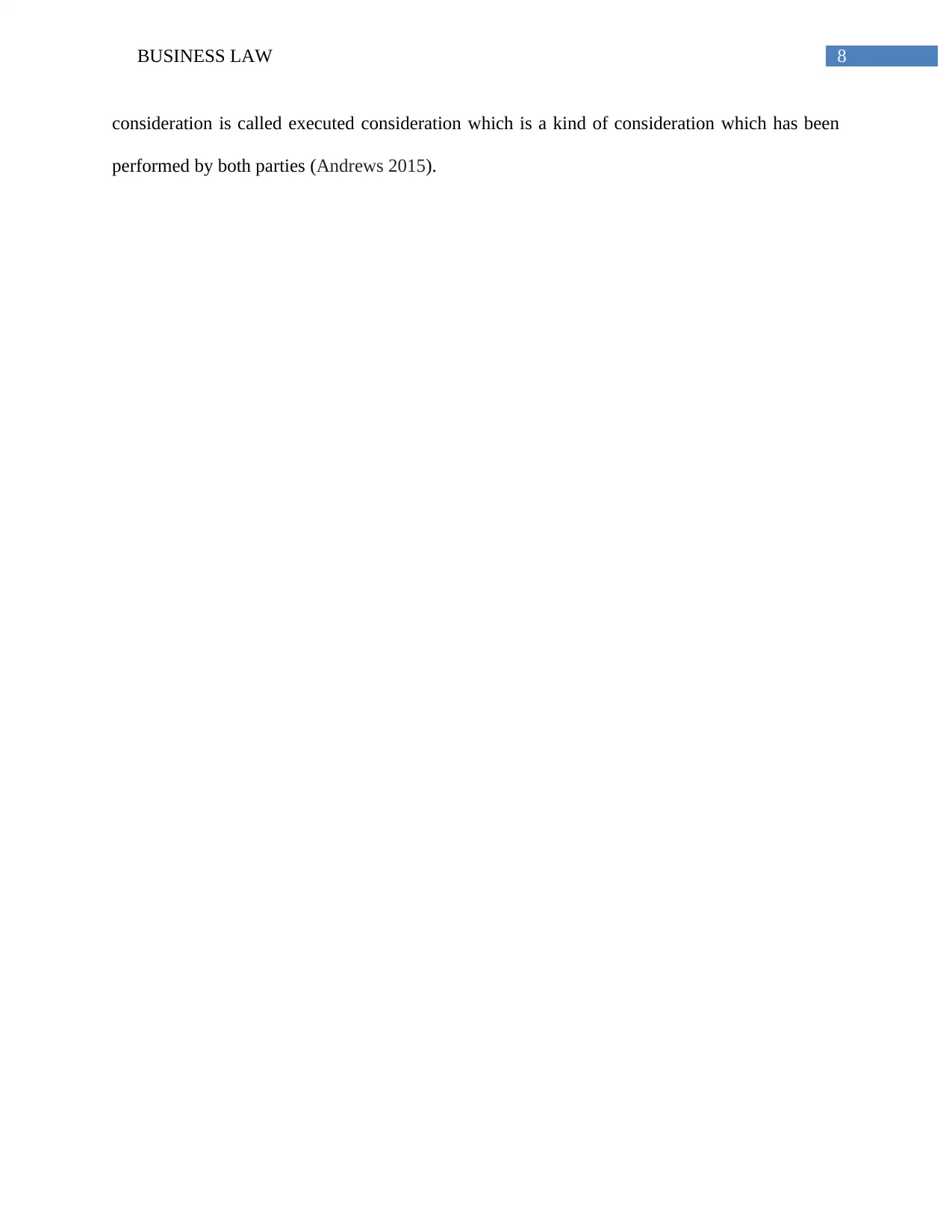
8BUSINESS LAW
consideration is called executed consideration which is a kind of consideration which has been
performed by both parties (Andrews 2015).
consideration is called executed consideration which is a kind of consideration which has been
performed by both parties (Andrews 2015).
⊘ This is a preview!⊘
Do you want full access?
Subscribe today to unlock all pages.

Trusted by 1+ million students worldwide
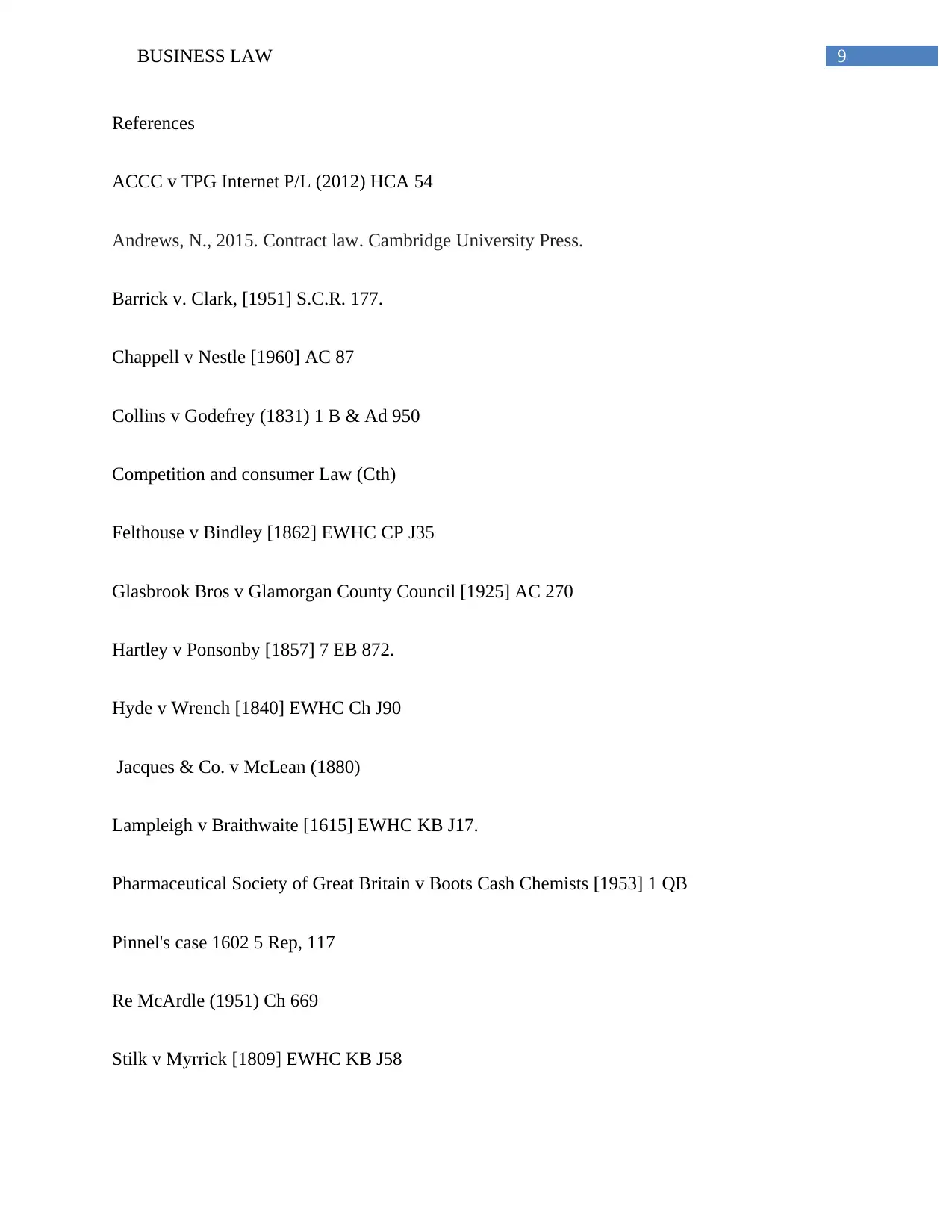
9BUSINESS LAW
References
ACCC v TPG Internet P/L (2012) HCA 54
Andrews, N., 2015. Contract law. Cambridge University Press.
Barrick v. Clark, [1951] S.C.R. 177.
Chappell v Nestle [1960] AC 87
Collins v Godefrey (1831) 1 B & Ad 950
Competition and consumer Law (Cth)
Felthouse v Bindley [1862] EWHC CP J35
Glasbrook Bros v Glamorgan County Council [1925] AC 270
Hartley v Ponsonby [1857] 7 EB 872.
Hyde v Wrench [1840] EWHC Ch J90
Jacques & Co. v McLean (1880)
Lampleigh v Braithwaite [1615] EWHC KB J17.
Pharmaceutical Society of Great Britain v Boots Cash Chemists [1953] 1 QB
Pinnel's case 1602 5 Rep, 117
Re McArdle (1951) Ch 669
Stilk v Myrrick [1809] EWHC KB J58
References
ACCC v TPG Internet P/L (2012) HCA 54
Andrews, N., 2015. Contract law. Cambridge University Press.
Barrick v. Clark, [1951] S.C.R. 177.
Chappell v Nestle [1960] AC 87
Collins v Godefrey (1831) 1 B & Ad 950
Competition and consumer Law (Cth)
Felthouse v Bindley [1862] EWHC CP J35
Glasbrook Bros v Glamorgan County Council [1925] AC 270
Hartley v Ponsonby [1857] 7 EB 872.
Hyde v Wrench [1840] EWHC Ch J90
Jacques & Co. v McLean (1880)
Lampleigh v Braithwaite [1615] EWHC KB J17.
Pharmaceutical Society of Great Britain v Boots Cash Chemists [1953] 1 QB
Pinnel's case 1602 5 Rep, 117
Re McArdle (1951) Ch 669
Stilk v Myrrick [1809] EWHC KB J58
Paraphrase This Document
Need a fresh take? Get an instant paraphrase of this document with our AI Paraphraser
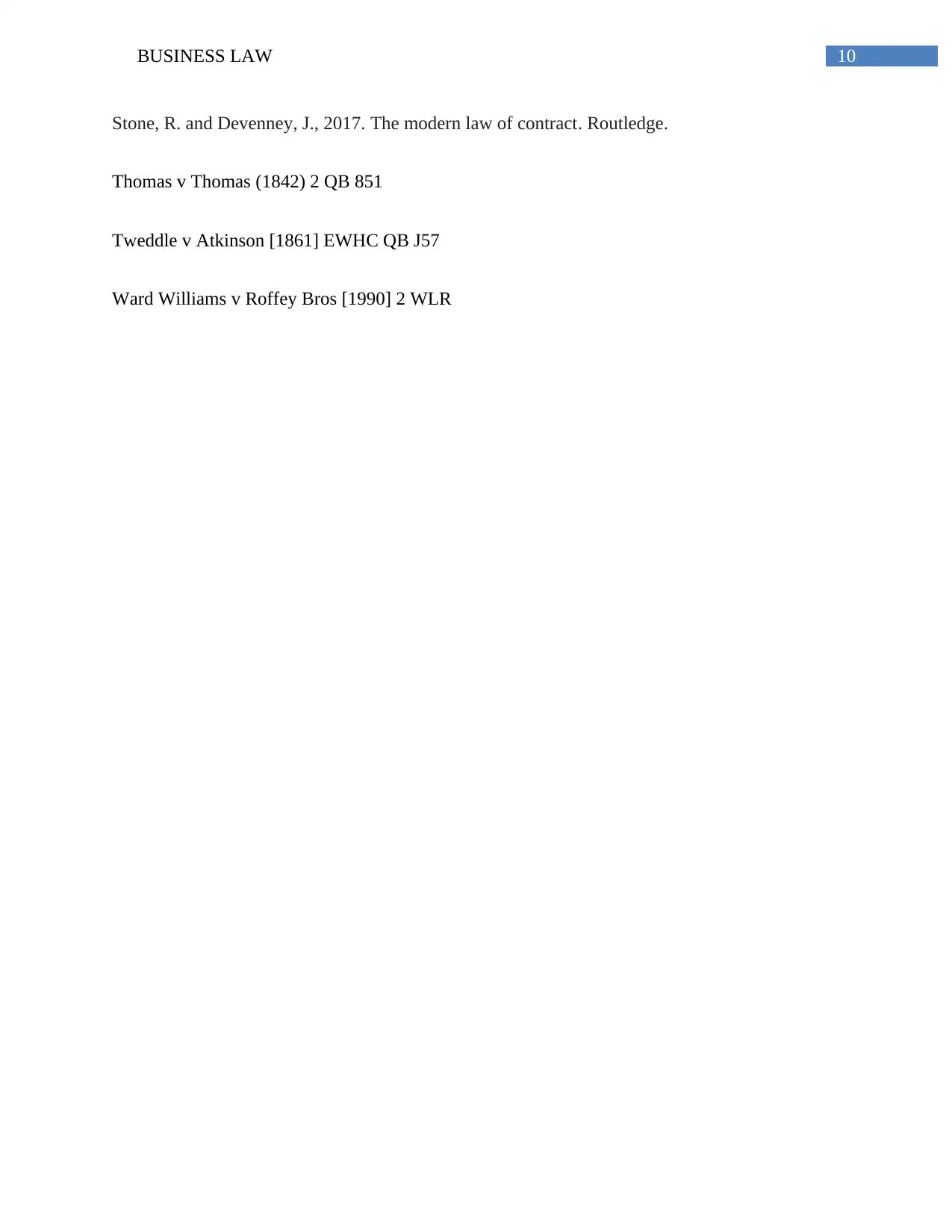
10BUSINESS LAW
Stone, R. and Devenney, J., 2017. The modern law of contract. Routledge.
Thomas v Thomas (1842) 2 QB 851
Tweddle v Atkinson [1861] EWHC QB J57
Ward Williams v Roffey Bros [1990] 2 WLR
Stone, R. and Devenney, J., 2017. The modern law of contract. Routledge.
Thomas v Thomas (1842) 2 QB 851
Tweddle v Atkinson [1861] EWHC QB J57
Ward Williams v Roffey Bros [1990] 2 WLR
1 out of 11
Related Documents
Your All-in-One AI-Powered Toolkit for Academic Success.
+13062052269
info@desklib.com
Available 24*7 on WhatsApp / Email
![[object Object]](/_next/static/media/star-bottom.7253800d.svg)
Unlock your academic potential
Copyright © 2020–2025 A2Z Services. All Rights Reserved. Developed and managed by ZUCOL.





